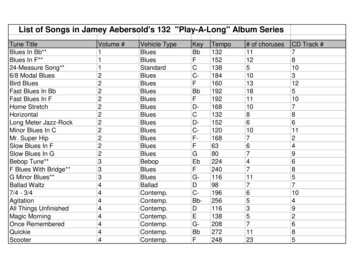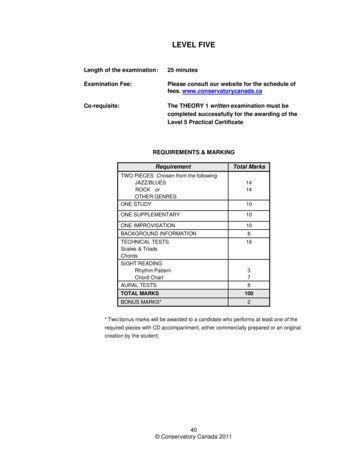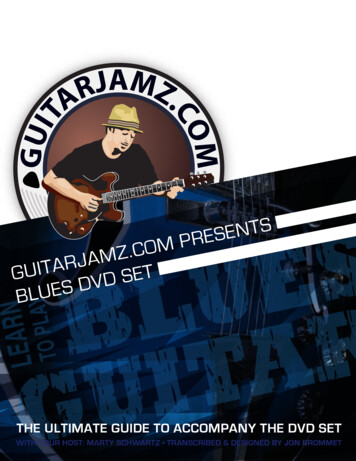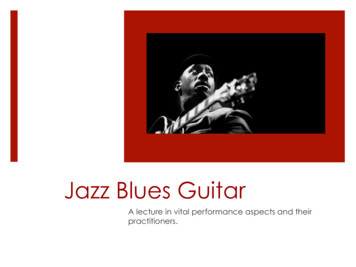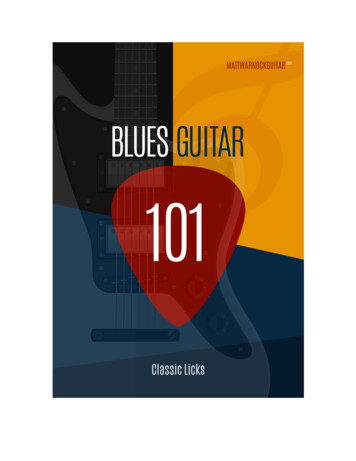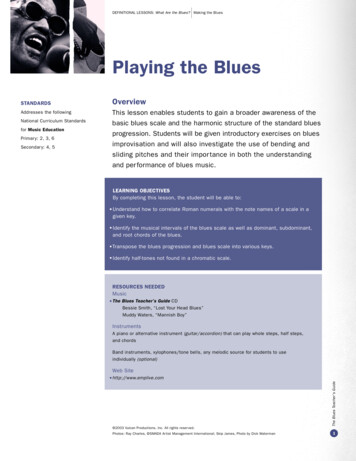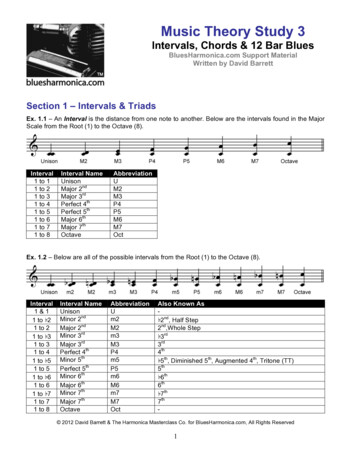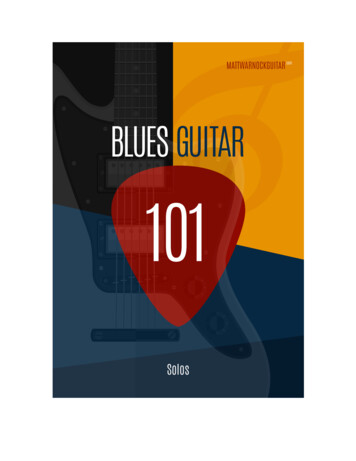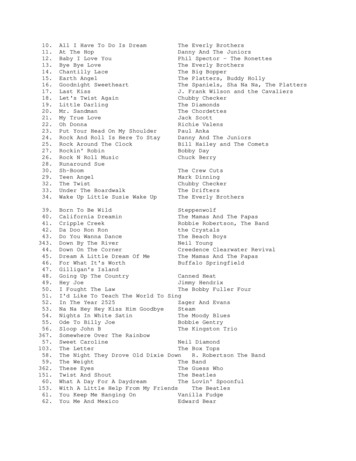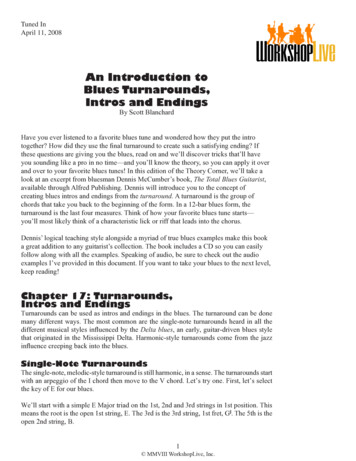
Transcription
Tuned InApril 11, 2008An Introduction toBlues Turnarounds,Intros and EndingsBy Scott BlanchardHave you ever listened to a favorite blues tune and wondered how they put the introtogether? How did they use the final turnaround to create such a satisfying ending? Ifthese questions are giving you the blues, read on and we’ll discover tricks that’ll haveyou sounding like a pro in no time—and you’ll know the theory, so you can apply it overand over to your favorite blues tunes! In this edition of the Theory Corner, we’ll take alook at an excerpt from bluesman Dennis McCumber’s book, The Total Blues Guitarist,available through Alfred Publishing. Dennis will introduce you to the concept ofcreating blues intros and endings from the turnaround. A turnaround is the group ofchords that take you back to the beginning of the form. In a 12-bar blues form, theturnaround is the last four measures. Think of how your favorite blues tune starts—you’ll most likely think of a characteristic lick or riff that leads into the chorus.Dennis’ logical teaching style alongside a myriad of true blues examples make this booka great addition to any guitarist’s collection. The book includes a CD so you can easilyfollow along with all the examples. Speaking of audio, be sure to check out the audioexamples I’ve provided in this document. If you want to take your blues to the next level,keep reading!Chapter 17: Turnarounds,Intros and EndingsTurnarounds can be used as intros and endings in the blues. The turnaround can be donemany different ways. The most common are the single-note turnarounds heard in all thedifferent musical styles influenced by the Delta blues, an early, guitar-driven blues stylethat originated in the Mississippi Delta. Harmonic-style turnarounds come from the jazzinfluence creeping back into the blues.Single-Note TurnaroundsThe single-note, melodic-style turnaround is still harmonic, in a sense. The turnarounds startwith an arpeggio of the I chord then move to the V chord. Let’s try one. First, let’s selectthe key of E for our blues.We’ll start with a simple E Major triad on the 1st, 2nd and 3rd strings in 1st position. Thismeans the root is the open 1st string, E. The 3rd is the 3rd string, 1st fret, G#. The 5th is theopen 2nd string, B. MMVIII WorkshopLive, Inc.
We are now going to take only the 3rd and the 5th of the chord and move them three fretsup the fretboard. The 3rd becomes the 5th of the chord, and the 5th of the chord becomesthe b7th of the dominant chord used in the blues.This is a very cool sounding change. If you put the root back into the chord, it becomesa 7th chord without the 3rd.To turn this into a turnaround, we will put the root back in and arpeggiate the chord in tripletschromatically down the neck until we get back to where we started. Let’s try it.Aww4& 4 #wœ œ œ b œ b œ œ œ œ œ n œj # œ n œ œETrack13SL001TAB400123130302213003let ring2H012w0 1100 1(0)0000Now, all we have to do is get to the V chord. We will approach it chromatically as well.Bœœ œ œ œ j nœ œ& 44 œ œ b œ b œœ #œ3SLTAB423130302213020211œ3let ringH0010 10000 B733œ bœ nœ #œœ œ(0)012012 MMVIII WorkshopLive, Inc.112300Œ
Harmonic TurnaroundsHarmonic turnarounds reflect the jazz influence on the blues. They are based on typicalchord progressions used in jazz standard tunes (the repertoire of songs that jazz musicianslike to play). The progression used the most is I–vi–ii–V. This progression is used in manyjazz blues standards. In the basic 12-bar form we’ve looked at so far, the turnaround beginsat bar 9. The turnaround in the following Bb blues begins a bar earlier, with the change tothe vi chord in bar 8.ATrack2Swing 8thsB b7B b7& 44 ’’’’ ’’’’ ’’’’ ’’’’ ’ ’ ’ ’ ’ ’ ’ 8213133321423Gmin711I766321Cmin7 F712viiiV1110121088886878213133321423Dominant 7thsThe blues is not often thought of as a complex musical form, and it’s true—it does not haveto be. But the fact is, the blues can be as complex as you choose to make it.One of the most common devices in blues music is the use of the dominant 7th chord forthe I, IV and V chords.In our last turnaround idea, you can make all the chords dominant 7th chords.Yes, even the minor 7th chords can be changed to dominant 7ths. Check it out:BSwing 8thsB b7B b7& 44 ’’’’ ’’’’ ’’’’ ’’’’ ’ ’ ’ ’ ’ ’ ’ ’TAB766321G78109101423C7988321F768781423 MMVIII WorkshopLive, Inc.766321G78109101423C7988321F768781423
Using Turnarounds to Create IntrosYou can create some really cool sounding intros simply by taking one of the many differentturnarounds available and starting your blues with one that fits. Who says you have to startat measure 1?ATrack3IntroSwing 8ths E7œœœ œ& 44 Œ œ œ b œ b œ œ œ # œœ3TAB433032B7œ bœ nœ #œ3302100012 1 0 2 1 0 2 1 000101201211œ323nœ #œ00Eœ œ #œ œ œ œ œ œœ œ œ œ œ œ œ œP.M.2204102010404030203010201040304030Let’s try one of our harmonic turnarounds. In this example, measures 9–12 will be ourintro.Swing 8thsB& 44 ’ ’ ’ ’ ’ ’ ’ ’ ’ ’ ’ ’ ’ ’ ’ ’ œ œ # œ œ œ œ œ œ1112109œœ 431255657555657555451121314312776711213143122 20 04 4 2 2 4 40 0 0 0 0 01 10 03 3 1 1 3 30 0 0 0 0 0Using Turnarounds to Create EndingsJust as we used them as intros, turnarounds can also be used as endings. Here’san example.ATrack4œœ œ& 44 Œ œ œ b œ b œ œ œE711TAB343302 1 03223021jœ120œ‰3H01 0 2 1 0#œ nœ10 100B733œ #œ œ #œœ0#œ nœ320 012012121 2 MMVIII WorkshopLive, Inc.300œ22ww#n wwwwE7001020001020
ConclusionFor more information on turnarounds, be sure to check out the Licks and Tricks section ofthis newsletter for some first-rate playing examples that’ll make you shine at the next jamsession!If you liked this excerpt, order Dennis McCumber’s book, The Total Blues Guitarist, atwww.alfred.com. In addition, be sure to check out his blues guitar lessons atwww.WorkshopLive.com today!To learn more about blues turnarounds, guitarists should check out the blues lessons“Turnarounds,” “Theory of 6ths,” “Soloing with 3rds and 6ths” and “Riff-Based Blueswith 9-Chord Turnarounds,” taught by Dennis McCumber, David Boye and Scott A.Smith.Keyboardists will enjoy the Adult Refresher lesson “Why Am I Blue: Blues Scales andProgressions,” taught by Leo Marchildon and Andrea Amos.Have fun trying out new ideas—see you soon! MMVIII WorkshopLive, Inc.
and over to your favorite blues tunes! In this edition of the Theory Corner, we’ll take a look at an excerpt from bluesman Dennis McCumber’s book, The Total Blues Guitarist, available through Alfred Publishing. Dennis will introduce you to the concept of creating blues intros and endings from the turnaround. A turnaround is the group ofFile Size: 1MBPage Count: 5
